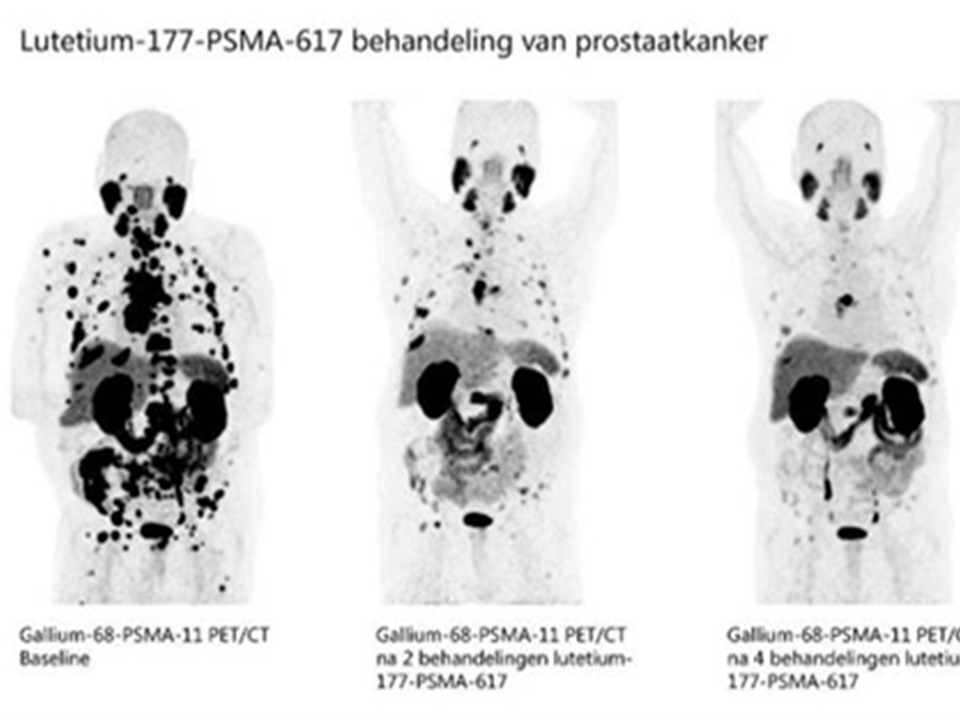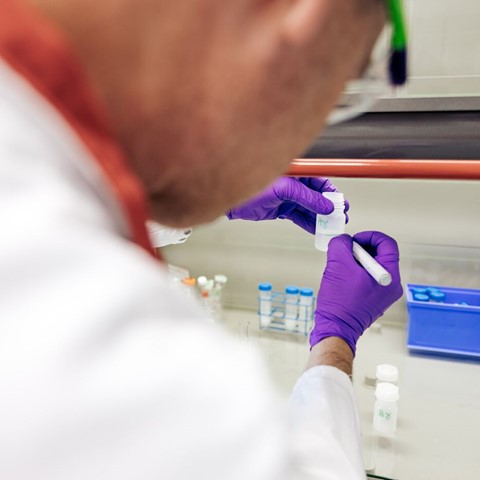What is Lutetium-177?
18 January 2023
Lutetium-177 (Lu-177) is a medical isotope used in targeted radionuclide therapy for treating neuroendocrine tumours and prostate cancer. It is produced in NRG’s nuclear facility and it is currently the most commonly used isotope for targeted radionuclide therapy.
This is due to its commercial availability and the clinical success of Lu-177 based peptide receptor radionuclide therapy (PRRT) for the treatment of neuroendocrine tumours.
This treatment and the treatment of prostate cancer targets and destroys the cancer cells, while leaving the healthy cells unharmed.
Do you have any questions about Lutetium-177?
Send us an email
Quickly to...

Lu-177 specifications
Lu-177 is a medium energy beta emitter (Eβ = 0.149 keV). It is quite damaging, but only deposits its energy within a short range, decreasing collateral damaging effects to normal tissues. It has a half-life of 6.7 days and is compatible with various targeting agents, ranging from short peptides to large biomolecules. The half-life also allows for transport over longer distances and on-site preparation of pharmaceuticals.
Lu-177 also offers many possibilities for theranostic applications like SPECT imaging and dosimetry evaluations, due to the co-emission of low energy gammas ().
How is lutetium-177 made?
Lu-177 can be produced in two ways, either directly by irradiation of lutetium-176 (Lu-176) or indirectly by irradiation of ytterbium-176 (Yb-176). The irradiation of Lu-176 leads directly to Lu-177, while irradiation of Yb-176 will lead to the production of the short-lived intermediate radioisotope ytterbium-177 (Yb-177), which decays to Lu-177.
What is the difference between carried added and no carrier added?
Carrier added (c.a.)
Using the direct method in which Lu-176 is irradiated (see above description), the Lu-177 is produced in a matrix (‘carrier’) of Lu-176, because only part of the Lu-176 is converted to Lu-177. This form of Lu-177 is called carried added. Also, the direct method leads to small amounts of the radioactive impurity Lu-177m. This lowers the radionuclide purity of Lu-177 and complicates the radiation protection and disposal of Lu-177 waste in hospitals.
The advantage of the direct production route is that it can create Lu-177 in high quantities by irradiating as little as 1 mg of Lu-176. On the other hand, the desired Lu-177 cannot be chemically isolated from the target material Lu-176, as they are isotopes of the same element. This is problematic as the lutetium administered to the patient should preferably only contain the ‘useful’ Lu-177. If it contains largely ‘useless’ Lu-176, the effectiveness of the treatment will diminish.
No carrier added (n.c.a.)
The indirect method, where ytterbium-176 is irradiated, does not generate this extra isotope. The Lu-177 is produced in a matrix of ytterbium, which is separated from the lutetium by a chemical process after irradiation. Therefore, it leads to Lu-177 no carrier added.
In the indirect production route, Lu-177 differs from the target material Yb-176 and can be isolated chemically in no carrier added (n.c.a.) form. Still, for large-scale production, 1,000 times more Yb-176, compared to Lu-176 (the direct route), must be irradiated due to a lower thermal neutron reaction cross section.
Are you stuck in the process of selecting a new nuclear isotope for your drug innovation?
FIELD-LAB is a drug discovery facility that will help you to speed up the development and market launch of new nuclear drugs for cancer treatment

What is lutetium-177-PSMA?
Lutetium-177-PSMA is Lu-177, bound to the protein PSMA (Prostate Specific Membrane Antigen). PSMA is found in the membranes of prostate cells. Men with prostate cancer have high PSA levels and PSMA expression.
The Lu-177-PSMA based medicine is injected into the body of the cancer patient. It then binds to the PSMA receptors on metastasised prostate cancer cells. Lu-177 emits damaging radiation, and since the Lu-177 is PSMA-bound to the tumour, the radiation damages the cancer cells, sparing the surrounding healthy tissue.
Contactform
Get in contact

